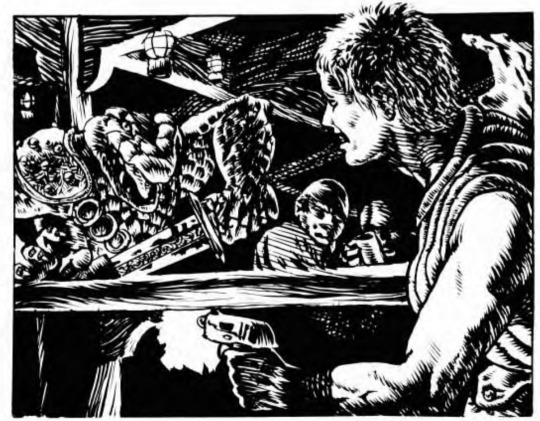#The Arduin Grimoire
Text

"Chaeronyx: A cross between a centaur and a medusa in appearance. Both males and females have the stoning ability. They are found only as mated pairs in deeply forested areas and are generally chaotic/evil." (Morno = Bradley W Schenck, The Arduin Grimoire Vol II: Welcome to Skull Tower by Dave Hargrave, Grimoire Games, 1978)
#Arduin#The Arduin Grimoire#Morno#Brad Schenck#dnd#medusa#centaur#Arduin Grimoire#Dave Hargrave#Bradley W Schenck#chaeronyx#The Arduin Grimoire Vol II#Welcome to Skull Tower#Grimoire Games#D&D#Dungeons & Dragons#flaming sword
137 notes
·
View notes
Text
As always, this was written on the fly without research or referencing anything else. So if I say something incorrect it's because I was forcing myself to work from memory and I don't want to look anything up as I write each part. If I research or discover something in between articles I'll add that info to the next article. This one likely contains misspellings, typos, poor wording, etc as again, I wanted to write on the fly conversationally and not sit and workshop it into a prose poem. I added a few things after I wrote the article but it will be clear what those parts are. In future articles I won't explain all this, just wanted to make it clear again as I get into the monster writeups.
PLEASE comment corrections, thoughts, insights, opinions, and insults. I'm lonely!
All the World’s Monsters: Readthrough Part II: Air Squid to Archer Bush(the complete “a”s!)
Finally! The Monsters!
That’s what I’m talkin’ about. All the text for the monsters is IN CAPS, SO THE ENTIRE ENTRY READS LIKE THIS. WHEN QUOTING I WILL NOT USUALLY DO THIS BECAUSE IT WOULD GET ANNOYING, DON’T YOU THINK? So if I quote “blah blah blah” it actually reads “BLAH BLAH BLAH.”
Air Squid
Starting off with a bang. I said before this is the kind of thing I love. Flying squids rule! So, let’s dive in(fly in?).
Each chapter begins with a drop cap, which is nice. The little detail of the fighter dropping their sword is cool. I dig it.

This is a Dave Hargrave monster, and that’s one of the names we’ll see a lot. It’s an intelligent monster, with IQ range 2d6, i.e., they have Intelligence scores of between 2-12, so, from almost animal intelligence to quite bright. Chaotic, neutral is its alignment, with the comma between the two just like that. Remember, in Holmes Basic, which this was following, PCs couldn’t even choose to be chaotic neutral - it was true neutral or nothing. I’m not sure if this applied to monsters - I’ll have to look through the Holmes list again. It may even be reflecting a single axis alignment system and noting that the creature could be either chaotic or neutral. Hmm. (I’ll know by the next article, I’m trying to more or less honestly write this on the fly!) (Note: I figure it out with one of the following monsters.) I won’t go into all this with future monsters, just a note for the first one.
Hit dice from 6-12d8+1, with size ranging from 35 to 75’ long. (I did read ahead through the A’s, and I thank Hargrave for clueing us in; you’ll find a frustrating number of monsters whose size is “shrug.”) Quite a spread, but not really illogical. It seems to be one of those things that early writers did that ended up not being the standard: giving many monsters a fairly wide HD range, where most monsters in official publications didn’t have any HD range at all.
AC of 7 seems okay, interesting that it doesn’t scale off of HD in any way, but not incorrect necessarily. Fly 12 seems reasonable. Dexterity range 1d6+6 is okay I suppose?
The air squid is found outdoors, in water(so presumably it swims too even though only flight speed is listed?), and of course, “air.” These don’t get as specific as other D&D writeups that would include mountains, swamps, forests, hills, and not just “in the air.” I don’t believe any monster stats had an entry or “slot” like that previously, like a part of the stat block or writeup that says “environment” or “terrain” or “found in.” I think it wouldn’t be til 2nd Edition that that became a standard part of the stat block. That info still existed by way of the wandering monster tables. For example, a monster is found on the tables for hills and mountains then obviously those are the two places in which they can be found. Also, the “interpreting the monster entries” section lists cities, mountains, and so on, so they were aware of the idea. Granted, the editors came up with the explanations for the environment types, or as they phrase it, “found in,” and apparently didn’t enforce much consistency. The air squid’s lair is “on mountain peaks.” Sure, why not?
15% chance in lair, only 1 ever encountered, and they always have a type E treasure.
Here’s where it gets really crazy: this thing has 13 attacks, and the size/HD doesn’t matter: the tentacles cause 1d8 points of damage in “constriction,” though there are no rules for this. Presumably the monster just grabs, crushes, and releases. Would it come to ground to do this? Just hover around the ground grabbing and crushing, not grabbing, holding, and flying up high to release? Meh. Plus a d10 damage with its beak. The damage not scaling isn’t really a big deal, but the attacks seem a bit wonky.
Why no ink spit? I’d find that a lot more interesting than a ton of attacks, personally. Being described as “sky-blue,” one would also expect a surprise bonus, at least situationally. Oh, and if you wondered how it flies? Hargrave didn’t just go with “Uh, magic, like, probably an insane wizard’s experiment or something, you know?” but instead attempted to give something of a naturalistic explanation with the squids being “helium-filled.” I can’t help but imagine popping a fully-inflated air squid with a well-placed arrow or spear. It could become like a mini game, with characters trying to pop air squids as they fly by. An attraction at the most incredible carnival ever to exist. Sure only 1 is supposed to appear but let’s be serious with our lack of seriousness.

Not much else to say about the air squid really. It’s pretty cool. With a generation of hindsight it could use some workshopping in my opinion but these were pioneers, dangit. The next entries won’t focus on some of the topics I focused on here because now they’re been addressed.
Airfang
The second monster in the book, and the first “..wtf?” Like, what actually is this thing? It’s apparently “tiny,” with an HD range of 8-12. What is “tiny” in this context, since official “size categories” such as tiny, small, medium, and large were not to come for a while(I don’t think it was until 2nd Edition AD&D)? Is tiny how I would interpret “tiny” if someone told me something was “tiny?” Itty-bitty? Probably not. A foot? Who knows how tiny this up to 12 HD monster with 2 attacks scoring 3d4 damage each could be?
It’s a “metallic scaled creature” with an armor class of 2+4(?) that is “mostly mouth, tentacle, and wings.” Huh. It reminds me of some of the random little enemies in old NES games that swarmed you and you had trouble even figuring out what the heck they even were. Of course, most of those didn’t eviscerate a starting character in a round or two by dealing massive amounts of tiny damage from its tiny tentacles and tiny mouth.
Is the 2+4 representing separate areas for the tentacles and body(because a “tiny” creature should definitely have different AC ratings by location, a mechanic that was kind of trash even on the few official monsters that used it). Or maybe they meant 2-4, which should more properly be 4-2, reflecting that the AC improves as it increases in HD?
Once again, we’re given very specific locations that these abominations can be found, such as “outdoors.” Well that sure narrows it down, thanks. Like the air squid, it’s also found in “water” and “air.” So, basically, literally everywhere. And why in Discordia’s name is it found in water anyway? It has scales and tentacles I guess? It’s faster than the air squid, with a flight speed of 24! I forgot to mention, it also “latches on with its mouth and then bites repeatedly,” so I’m not sure if this implies that it only has to attack once with its mouth and then it auto-hits, or if this is just a descriptive visual, but either way, it’s pretty lame.
You encounter 3d6 of these, too. 3d6 tiny, indescribable monsters that inexplicably have a mountain of HP and have the potential for enormous damage, swarming a PC. Just imagine using these and explaining how their appearance is totally silly, they’re too tiny and fast to potentially make out, one of them took an entire round of hits from the entire party and didn’t die, three of them reduced one party member to bones in a round, somehow, and potentially, some of them are automatically inflicting damage after “latching on.” If your players don’t quit on you, you’ve either built up a huge Loyalty rating with them, or they’re just very, very lacking in discrimination. Or perhaps you knew they’d enjoy a good, absurdist comedy encounter.
Its alignment is “hungry,” hahahahahahahaha! :| If this was a one-off joke, or it was a monster that was otherwise good, it’d be okay. Sadly to the first one, having peeked ahead, this isn’t the first time this “gag” is done in the “a” monsters alone.
To the second one: this monster sucks. I have trouble believing that out of 5 billion entries, this boring, overpowered, uncreative nonsense was one of the best.

Mystery solved; turns out, this is an airfang
Ant Man
An obvious idea that would be done a number of times - and I’m not saying that as insult, at all - this version is based on creatures from a book, “Kavin’s World,” which could also be the name of a sci-fi sitcom.
These also have a very wide HD range, from 1-14. Not having read the books or feeling that it would be worthwhile to research it, I can’t say how widely the ant men in it varied in strength. Their AC does not vary, at a very high 2. So even the single hit die ones are as tough as plate mail. They only move 6, so, fairly slow(I’ve seen some relatively quick ants). Their intelligence skews towards good - 2d6+6, varying from low to genius and averaging at high(13). Dex is average(3d6). Seems to me an ant’s might be a bit low, comparatively, but hey.
Neutral alignment is fair. Again, I have no idea how these things are in the book. They appear a lot of places, but no place unreasonable for an ant, much less an alien ant or whatever these things are. 200d20 of these appear in a lair, which even by ant standards seems pretty high, but book yadda yadda. Wandering or in lair they have the same amount of treasure, and a 100% chance of it, at that. Seems a bit odd but whatever.
Boy do they get a lot of attacks. 2 “hands”(quotes theirs), 2 stings, and a bite, scoring up to 44 points of damage plus poison from the stings which cause 4d6 on a failed save for another potential 24 damage… yikes. Keep in mind, this describes the 1 HD version and the 14 HD one. A 1 HD monster that can potentially cause 68 HP damage in one round. The bite says “HIT -2” but I’m not sure what that means. It’s a -2 to the attack roll with the bite? Or the damage is 2d6-2? I’m guessing the former, but I’m not positive.
Ant men are big-ass ant people with four arms, two which end in stingers, because sure! and two end in “hands” that score damage as a two-handed sword. They’re also immune to “mental spells,” which I assume means charm, fear, illusory magic, probably hold, and so on. They believe that other sentient species, including those with demonstrably similar intelligence, are cattle, which is not a very true neutral position to hold. Sounds neutral evil or lawful evil at best. “True Neutral. I believe that there should be a balance in all things. Nature is balanced, law and chaos must be balanced, good and evil must be balanced. And everyone not of our race are animals to be used as slaves and food.” Not seeing it.
I don’t know what to make of this one, but it’s not the strangest one I’ve seen so far, so it’s okay.
Ant, Giant
An expected monster, a classic. Is this the first time a giant ant was statted in print? I don’t know, but IT HAS FROM 1-27 HD. But it also doesn’t give an actual size range, so I imagine this is so you can stat from chihuahua sized giant ants to “Them!” giant ants up to true kaiju giant ants. This is also the first one we’re seeing that has an AC that scales to its HD, in this case “its armor class is 3 plus one third of the number of its hit dice, fractions are rounded up giving a range of 2 to -6.” Chuck Cady did well, I like it, and obviously pleasing me is everyone’s top priority.
Its damage also scales, +1 per HD, which gets pretty high - arguably, unreasonably so - but on the other hand, one of my biggest gripes at high levels is how bad the damage often is by high level monsters(the tarrasque doesn’t do jack in damage to any party high enough in level enough to fight it), so I’m just a hypocrite. Wait. I just realized. I thought it was +1 per HD + acid, and it’s actually +1d3 per HD in acid damage. So a 27 HD giant ant doesn’t get +27 damage, it gets +27d3 damage. In acid.
So its bite doesn’t scale, with a 1 HD rat-dog or a 27 HD kaiju ant scoring the damage of a short sword… plus or minus a few dozen d3 in acid. It seems really weird to me that the acid scales that greatly and not the bite, but… I’m kinda okay with it?
Do ants use acid? Hmm. Well, slugs don’t, so. At least there are only 3d20 of them in their lair and not 2,000+ of them like ant men.
“Alignment: any, hungry.” C’mon, Chuck. I’m introducing good-aligned giant ants and blaming you. The giant ant appears in all the same places as the Ant Man, even though this has a different creator. Ants can be found about anywhere, though…
I would be remiss not to mention the incredible description: “The generic description of the giant ants.” (In all caps of course.) Now we’ll never know exactly what an ant looks like. “I once lay awake long into the night, wondering just what kind of creature was the noble ant.”

Ape, Desert
Back to Hargrave with another pretty decent monster. Desert apes are apes with a literal third eye with accompanying hypnotic powers. I think I’d have liked to see a full-scale psionic ape, but this is cool. Movement 10 is a bit unusual for the way this game scales movement, but I don’t have a problem with it. HD spread on this one is only 4-8, reasonable for rank and file apes up to the leader. Intelligence averages low at 2d6, with dexterity being high, equaling that of the very agile giant ant and ant man(for whatever reason). AC 4 is.. all right I guess.
Chaotic neutral is okay, though I dislike the tendency to lean towards that alignment that seems to have existed since the beginning. I’d like to see hypnotic apes that are more lawful, allowing them to better take advantage of their incredible power, but honestly this isn’t a complaint. Despite how it may sound, very few of my comments are “complaints,” merely observations, though I may make them in a sardonic way in a lame attempt at humor. The truth is I highly respect the effort and passion that is put into these kinds of works, even if I joke otherwise.
Found in “dungeons, open, deserts.” Can we just skip listing “dungeons?” Literally every smegging monster to ever exist is found in dungeons. Pterodactyls are found in dungeons. I’m sure treants are found in dungeons. Like, literally every monster is indexed to a specific “dungeon level” for the purpose of putting them in dungeons. There’s really no need to state “dungeons” on every single monster. Also, what is “open?” Is that the same as “outside?” Or do they mean non-forested, non-mountainous regions, like plains or something? The opening explanation for the book doesn’t list “open,” so it’s another case of monster creators doing what they want and the editors not enforcing any kind of continuity. It’s not a big deal, but I have to comment on it in a readthrough.
Two attacks, one being a rather heavy club(scoring 1d8 damage) and the other, hypnosis, which is listed as an attack with no real indication of what “hypnosis” actually entails, though it lists it as a “visual” attack, I guess because it’s using one of its eyes, so perhaps it means a gaze attack? Not sure if “gaze attack” was a term cemented into D&D/AD&D yet. Either way, is hypnosis the same as charm, or…?
These apes cannot speak a normal language, though you might imagine they could, being of low human intelligence and having hypnosis and stuff. Alas, ape biology simply doesn’t allow for the forming of words like we use, and there’s no such thing as evolution or crazy magical effects to cause this to happen, and so we’re stuck with psionic apes only communicable with through magic such as speak with animals, and we’re told these chaotic neutral scoundrels will lie 30% of the time.
Ape, Snake
This is one of those monsters that when you look at the name you just try to guess what it might be. An ape made of snakes? An ape with snake arms? An ape filled with snakes? This is another Hargrave monster, with the most reasonable HD spread so far, 5-7. these small spreads are okay(not saying the larger ones can’t be, they’re just uncharacteristic of what we tend to see in official writeups). Technically they exist in AD&D for various humanoid monsters as well, they’re simply expressed differently: a stronger kobold is statted as a goblin, an even stronger one as an orc, etc. By the time you get to hobgoblins, their strongest members are statted as ogres. So their HD could have been shown as “1+1 - 4,” and it would have been a greater spread than the snake ape.
Let’s skip to the description to see what this thing actually is. One line leaps out and suckers my face with tentacles: “Also known as an octorilla.” Dave, buddy, you could have called this an octorilla and you went with snake ape instead? Octorilla is much cooler, and gives an almost immediate idea of what it might be like. Was it so it would go into the book earlier, like why people give their businesses names beginning with “a” so they get in the front of the category in the yellow pages(back when people used yellow pages)? Tentacles aren’t snakes, Dave. “But maybe people back then wouldn’t have known!” People “back then” wouldn’t have known half the stuff we put in these games, let’s move on.
So, this thing was “spawned in the vats of chaos,” which was basically the precursor to “probably the result of a mad wizard’s experiment.” Both of these are the equivalent of Marvel Comics’ “they’re a mutant.” They are what they are and we don’t have time to come up with origins and explanations, dammit. (Not even kidding - mutants were created because Stan Lee was too lazy to continue to come up with origins for characters so he basically said “what if a mad wizard(God) did it?” I’ll wait for angry responses from Stan Lee fans “correcting” me about something I couldn’t actually care less about.)
AC actually has a range, from 6-7, or as I observed previously, should probably be listed as 7-6(I won’t comment on this in the future). Move 8 seems okay I suppose for an octorilla. Swim 6, so, it’s better running around on land than swimming. Intelligence very low, but not quite animal, averaging 5, with a high dexterity averaging 16! Why exactly?
Alignment “chaotic,” so I suppose they are going with the single description alignments. Found in dungeons and “open,” again, among other places, specifically woods and water, which makes enough sense.
This is another with way too many attacks. I really miss OD&D with 1 attack per character or monster regardless of how many arms it has or whatever. Two of its three attack types have scaling damage, and it’s high damage. It gets 4 attacks with its arms, which I guess is a punch or slam of some type, beginning at the same damage as a two-handed sword. The largest cause double this damage. Its beak begins at 1d8 and can also double for the largest ones. It also gets four “constrictions,” which score double its “regular damage,” so, 2d10 for the smallest and 4d1 for the largest? You know that’s overkill. 7 HD giants don’t do that kind of damage in a single attack(though they should). The description tells us that if a sucker-lined arm hits twice in a row or two arms hit in one melee turn(which was probably still 1 round in Holmes and not 10?) constriction takes place and continues until either party is dead. This is when I’m noticing it actually says “1-4 constrictions,” so maybe it only gets the arm attacks unless the previous conditions are met? It’s kind of confusing, and generally, such conditional attacks aren’t listed among the regular attacks like that, but this was an early time. It would certainly make the monster more reasonable if that’s the case. It also says that there’s only a need to make an attack roll for constriction “each turn” if someone is wearing plate mail. That tells me they do mean rounds, but what is the roll for? If they’re saying if an arm hits twice in a row or two hit in a round, the constriction is automatic, then there was already an attack roll made - two of them. Are they saying that constriction isn’t automatic if someone is wearing plate mail? I don’t get this at all.
Aside from some confusing aspects, including what this abomination actually looks like(sure, gorilla and octopus, complete with octopus beak - I still have no idea what that would look like), it’s a neat monster. I like it.
After completing Part II of this readthrough, I looked up “octorilla,” and found that such a monster was published in “the Arduin Grimoire II,” by Mr. Hargrave here. Perhaps Chaosium appealed to Hargrave to change the name because the book was lacking in “a” monsters, or he only really finally decided on “octorilla” between AtWM and tAGII, but I doubt it. Also remember that the introduction expressly stated that no “Arduin Grimoire” monsters are found here, and the second volume of tAG hadn’t been released yet, so this was probably a precursor to the later Arduin “octorilla.” You can see an OSE writeup and the original monster writeup here, complete with pictures(the modern version, not by Hargrave, skips the beak!).
Arceel
It would be understandable to think this was a made-up nonsense word by emphasizing the pronunciation incorrectly, like “ar-keel” or even “ar-seal,” but it is “arc eel,” as in electric eel. It’s man sized, and 10 HD! Sheesh!
The AC is 2+6, the same thing its creator, Steve Henderson, did with his last entry, the nonsensical Airfang. “Its AC is high due to its rubbery skin.” Thanks for the important info, why does its Dex average high though? Also, it’s “repulsive,” lest you think it was adorable.
It has low human intelligence, but never lairs nor has treasure(I guess it’s the lack of hands?). Chaotic in alignment, it only lives in swamps - not “outdoors” or in dungeons - and its swim rate is abysmal, maybe to allow PCs to escape when they realize this thing is an inexplicable bucket of HP that does 4d6 lightning damage. It’s described as a “lightning bolt,” but clarifies in the description that it “must touch its victim.” I’m not sure if “must touch” simply indicates that an attack roll must be made as opposed to it being an area of effect power, or if it also means that someone touching it takes damage.
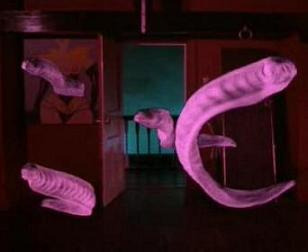
These eels are a lot cooler, put them in your game instead
I wish it flew like the air squid. Water-based monsters get so little use, comparatively, in my opinion(though this could be a flaw in execution, i.e., people need to find ways to use them more). And the HD seems pretty high, really. I know it’s a nitpick, but I don’t care for the cutesy name either. Why not just call it “giant electric eel?” That’s what it is, man. It doesn’t even have acid or cold breath given to it by a mad wizard, or that it gained in the vats of Chaos, so it’s just a big-ass electric eel.
Archer Bush
This is one we’ll see other places, such as Mystara. I suppose it’s one of those natural or obvious ideas that multiple people come up with, as mentioned before. It’s mentioned as being taken from the book “Symbiotica,” so it’s just as possible that whoever created it for Mystara was inspired by the same book.
It has no intelligence, but usually has treasure; which makes sense as it’s described as being a “guardian” creature, planted almost invariably for such a purpose.
No alignment is given, not even a joke one like “alignment: wood.” That’s not funny, but neither is “hungry.” Speaking of which, it’s found in “open,” as well as woods. So I guess “open” must mean literally any outdoor area at all aside from cities, which are listed as their own environment, and ruins, which are actually considered part of the “cities” category for some reason. Which means technically, nobody ever plants these in the ruins in which they lair, nor do wealthy lunatics plant them around their yard for security. I’m sure the creator didn’t intend to make their use that narrow, I’m being pedantic, or something similar to it. I don’t think it actually needs an alignment, and sometimes I think systems overstat things that don’t need them. (DC Heroes was the worst for that, statting things like coins - and by the rules, the weakest human can snap one in half.)
One of the most reasonable HD attributions so far, and it doesn’t even have a spread! The AC is pretty low for something that could logically be argued to be a bit higher. Its dexterity is 12, so it’s going to act in melee a little faster than an average person; too bad it doesn’t get melee attacks, and it isn’t high enough to give it a bonus to its ranged attack, and monsters don’t really work like that anyway. It attacks with the “probability” of “a light bow fired by an eighth level fighter of average dexterity.” I don’t put “probability” in quotes to mock it, but to highlight a specific way that certain rules were often expressed early on that you didn’t see so much later. If you read the “AD&D Dungeon Master’s Guide” - and I‘m going to write a short article in the future on why you should, regardless of what RPG you run, and what parts are universally useful and often overlooked - Gygax goes into dice probabilities, and describes the potential universality of die rolls and how one can be exchanged for another. I talked about this a bit in the previous part. Looking at chances as probabilities, converting them to percentages, can be very useful. I also point this out to question why “light bow” is mentioned. One could argue it’s to reflect the range or damage or something, but it expressly states that it factors into its hit probability somehow.
It certainly doesn’t factor into its damage, which is insane: it fires 50-100 needles, each of which score 1 HP damage, so we’re talking 50-100 HP of damage potential per round from one bush alone and they average 21 appearing at a time. And that’s before poison, which is save or die, meaning an average of 1,575 possible save or die attacks PER ROUND. That assumes all 21 are within range, but still.
Well, we’re done the “a”s, and I could use a breather after that last one. K. Jones, I’ll be watching you.
Next time we sail into the “b”s, with the Bagda and Fallowman, and, oh I don’t know, tentatively end with the writeups of beetles. See you then!
5 notes
·
View notes
Text
Arduin Dungeon #1 Caliban
Arduin Dungeon #1 Caliban
Arduin Adventure #1 Caliban by Dave Hargrave from 1979. Describes itself with:
This dungeon was deliberately constructed as a very dangerous and high level dungeon.
Dave Hargrave 1979
This an adventure from the early days and written by an outlier of the hobby. Dave Hargrave had created his own world of Arduin and built what he described as his own game system of the same name. Arduin was…

View On WordPress
0 notes
Photo

In California’s atmosphere of psychedelic medievalism, Eliade’s influence was more direct. The Bay Area was home to a variety of growing movements: the Society for Creative Anachronism, growing neo-paganism, and a lot of people who were into D&D. One of them, David Hargrave, produced a variant of Dungeons and Dragons in the mid 1970s that he published in a series of books known as the Arduin Grimoire. Hargrave built the magic system for his game with the help of Isaac Bonewits, the future Archdruid of the New Reformed Druids of North America. Bonewits shared Eliade’s love of synthesis and sense of adventure—he had a bachelor’s degree in ‘magic’ from the University of Califoria, a major of his own design Bonewits certainly read Eliade, and worked to synthesize the disparate religious systems he read about into a single system. The result, was ‘neo-paganism’ a movement that Bonewits helped found. In fact, in 1978 Bonewits produced the book “Authentic Thaumaturgy” which described how to create in-game magic systems based on how real magic worked. The Arduin Grimoire, RuneQuest, and other games drew strongly on Bonewits expertise with ‘real’ magic when they designed their ‘fantasy’ versions.
(via The History of Mana: How an Austronesian Concept Became a Video Game Mechanic—The Appendix)
13 notes
·
View notes
Text
Galleytrot

“Barghest” © George Bennett, accessed at his ArtStation page here
[Commissioned by @crazytrain48, based on the moon dog from The Arduin Grimoire. Arduin’s moon dog predates the canonical good-aligned moon dog from D&D (which also appears in Pathfinder due to the Tome of Horrors’ licensing agreement), so I had to change the name. Fortunately, just about every county in Britain has its own name for a spirit dog, so I had plenty to choose from.]
Galleytrot
CR 4 NE Magical Beast
This monstrous hound is pale in color, limned in an eerie glow with eyes like lamps. Its teeth and tongue are black, and its breath steams with corruption.
Galleytrots are dog-like monsters that associate with the undead. Mindless undead like skeletons and zombies are completely passive around these creatures, and intelligent undead tend to view them favorably. They are especially prized by vampires, who use them as hunting hounds. Galleytrots can consume rotting and desiccated flesh, and are happy to feed on the bodies of a vampire’s victims that have been drained of blood.
Galleytrots are pack hunters, and are rarely found alone. They use their baleful howls to cause opponents to run in fear, flushing them towards other pack members waiting in ambush. Galleytrots favor multiple hit and run strikes, and flank whenever possible. Their bites strike with the force of a greataxe and carry a hallucinogenic venom—those that succumb to it become a danger to themselves and others. Galleytrots often spare confused victims from their primary attention, allowing them to lash out at allies or injure themselves before the dogs return to finish the job.
Galleytrots are nocturnal and love to hunt on nights of the full moon. They are sometimes referred to as “moon dogs” because of this habit. True moon dogs are benevolent outsiders, and view galleytrots as enemies to be dispatched. Galleytrots sometimes run in mixed packs with other monstrous canines such as hell hounds, yeth hounds and shadow mastiffs.
Galleytrot CR 4
XP 1,200
NE Medium magical beast
Init +2; Senses darkvision 60 ft., Perception +10, scent
Defense
AC 16, touch 13, flat-footed 13 (+2 Dex, +3 natural, +1 dodge)
hp 37 (5d10+10)
Fort +6, Ref +6, Will +3
DR 5/magic; Immune ability damage, ability drain, energy drain, sonic
Defensive Abilities death blessed
Offense
Speed 50 ft.
Melee bite +6 (1d12+3 plus poison)
Special Attacks howl
Statistics
Str 14, Dex 15, Con 14, Int 6, Wis 15, Cha 13
Base Atk +5; CMB +7; CMD 20 (24 vs. trip)
Feats Dodge, Mobility, OutflankSkills Acrobatics +6 (+14 jumping), Perception +10, Stealth +6, Survival +3 (+7 tracking by scent), Swim +6; Racial Modifiers +4 Perception, +4 Survival when tracking by scent
Languages Necril
Ecology
Environment any plains
Organization solitary, pack (2-13) or horde (14-60)
Treasure incidental
Special Abilities
Death Blessed (Su) Unintelligent undead such as zombies and skeletons never attack a galleytrot unless that galleytrot attacks them first. If controlled by another creature, that creature can command the undead to attack the galleytrot, but must succeed an opposed Charisma check or its command is ignored.
Howl (Su) As a standard action, a galleytroy can bay, causing all creatures within 60 feet to make a DC 13 Will save or be frightened for 1d6+1 rounds. A creature that succeeds this save is immune to the howl of that galleytrot for the next 24 hours. This is a mind-influencing sonic fear effect, and the save DC is Charisma based.
Poison (Ex) Bite—injury; save Fort DC 14; duration 1/round for 4 rounds; effect 1d3 Wis damage; a creature that takes Wisdom damage must succeed an additional DC 14 Will save or be confused for 1 minute; cure 1 save. The save DC is Constitution based.
117 notes
·
View notes
Photo
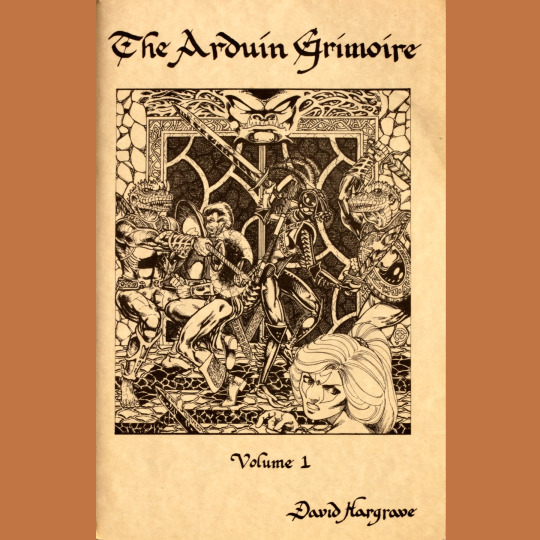
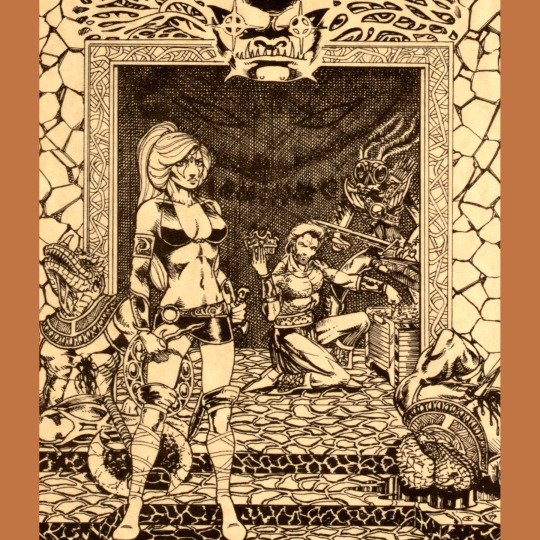
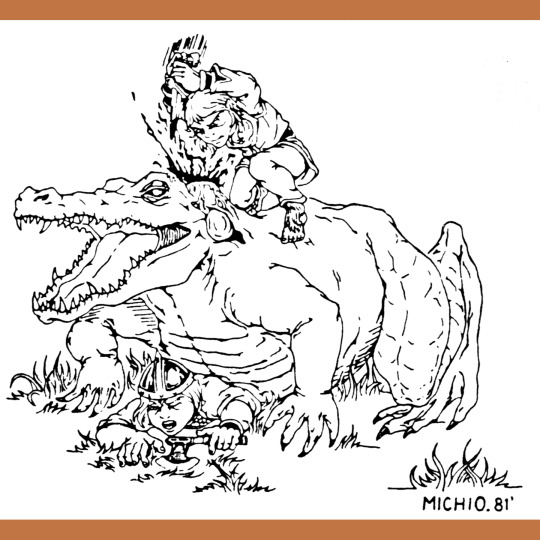
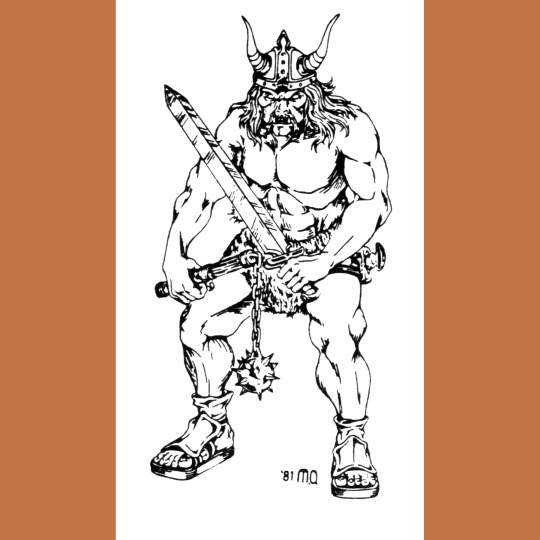


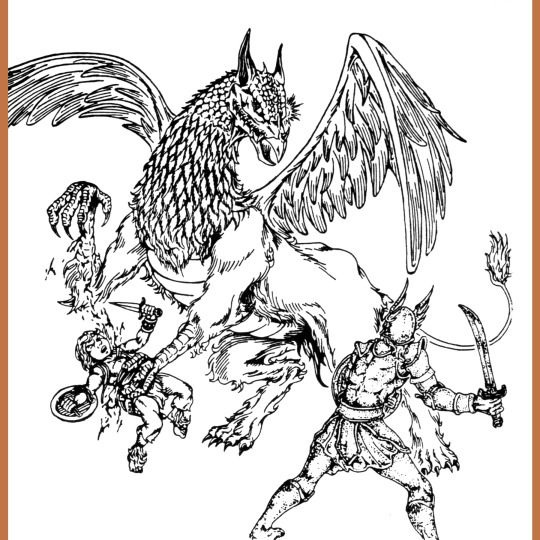


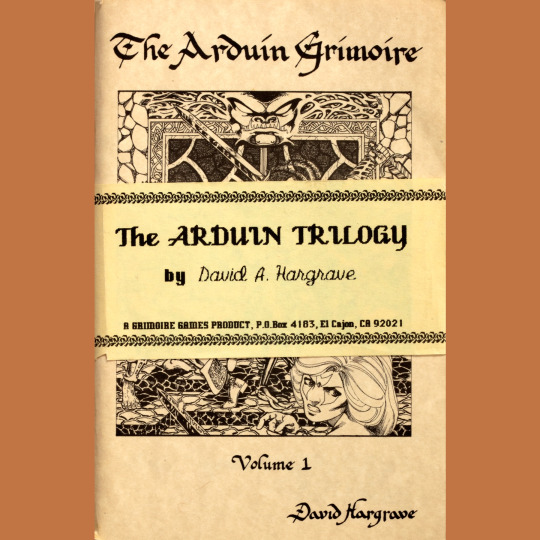
It took me a long time to put together a set of David Hargrave’s Arduin Grimoire books but holy wow, was it worth the wait. This is the first, The Arduin Grimoire. Originally self-published in 1977 with different art, this edition is part of a three-pack “Trilogy” issued by Dragon Tree Press around 1984 (last pic). The project was born out of Hargrave’s heavily house ruled Dungeons & Dragons campaign.
Because these books are named after Hargrave’s fantasy world, I kind of expected a primitive sort of sourcebook, but no, they are just a collection of house rules. While they are organized around how they work in Hargrave’s world, and there are many things implied by the rules (the Techno class, for instance, and their use of sci fi technology), we don’t ever get a clear picture of the lands of Arduin in the Grimoires (not unlike the Greyhawk supplement, honestly). But that’s OK, because the rules? Pure gold.
While the book never explicitly says so (for legal reasons, obviously), the rules are intended as modular expansions to the original white box D&D. Even knowing that, though, doesn’t make parsing them very easy – Hargrave is constantly referring to a mountain of material, only portion of which is in any given book. The “How to Play the Game” section is largely devoted to the mechanics of overland travel. I needed to get through all three volumes of the Trilogy before I had a handle on things to the point I could probably incorporate them into a game.
There is so much, I don’t really know where to start. How about new classes? We’ve got Merchant, Psychic, Barbarian, Rune Weaver, Techno, Medicine Man and Witch Hunter. We’ve got piles of new treasures, monsters and spells. We’ve got musings on alignment, modified approaches to character creation and combat and a gloss of the 21 layers of hell. And charts! So many random charts! For mist generation, for fumbles, for character special abilities (some good – natural mechanic! – some bad – bad liar!), for traps.
If Arduin Grimoire isn’t the clear precedent for the idea of OSR rules hacking, I don’t know what is.
#RPG#TTRPG#Tabletop RPG#Roleplaying Game#D&D#dungeons & dragons#Arduin#Arduin Grimoire#David Hargrave#Michio Okamura
96 notes
·
View notes
Text
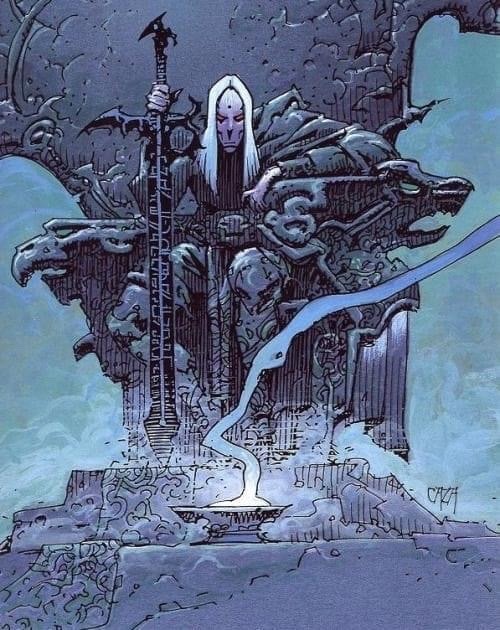
“Elric” by Phillipe Caza
28 notes
·
View notes
Photo
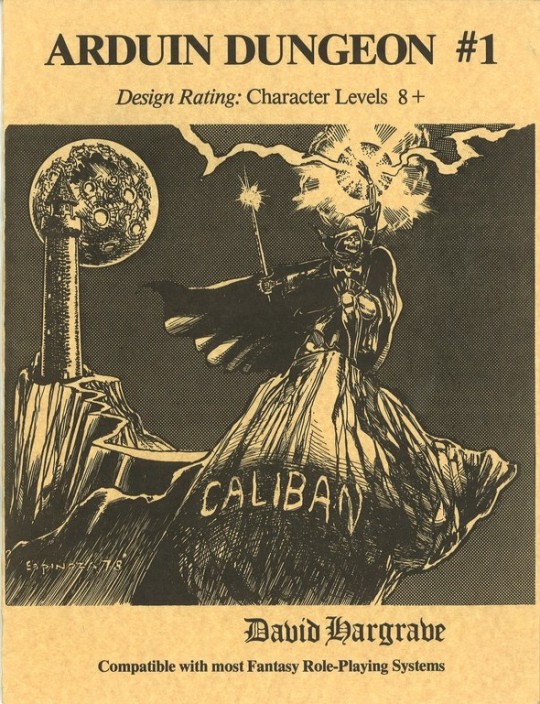
Arduin: Caliban ~ Grimoire Games (1979)
110 notes
·
View notes
Text
Thanks, Alendil
I will 100% understand if y'all don’t find this funny, but every gamer I’ve told this story to has laughed, so here you go, but I’d better set the scene.
The date is September, 1979. The place, meeting rooms above the Student Union of a university that shall be nameless. I am a femme-presenting skinny little white girl freshman and this is my first Saturday at college. Making a good faith effort to come out of my high school shell, I have looked over the announcements of group meetings and found a notice that players for fantasy role-playing games should meet in this room at this time. I have no idea what a role-playing game is, but if it’s fantasy I’m game to check it out. I am the only female in the room. Everyone is excited because the AD&D Dungeon Master’s Guide has just come out (yup, the one with the efreet and nearly-naked magic-user babe on the cover) and two people had acquired them. I have no idea what’s going on, but roll the dice (4d6, drop the lowest) that are put into my hand and note down the numbers (in order as rolled) as instructed. I wind up with a high score in Dex, which I’m told makes a good thief, and when asked what race I wanted, I asked what my choices were. I was told that elves, half-elves, dwarfs, humans, and halflings made good rogues.
Me: Okay, I’ll be a dwarf.
Name Withheld to Protect the Guilty: You’ll have to be male, then. Female dwarfs never leave home.
Me: What?
NWtPtG: Yeah, there’s like, only one born per hundred so they have to stay home making babies and are guarded like diamonds.
Me: That’s dumb.
Fellow Freshman: That’s not how it works! The race would die out.
Argument Erupts, including the inevitable side argument on the burning issue of Female Dwarf Beards; interrupted by Authoritative Senior smoking a pipe and reading DMG, without looking up. “Let her play a female dwarf.”
NWtPtG subsides grumbling, works on his own character while I flesh out and equip Alendil, First Level Dwarf Thief, with black skin, auburn hair, and amber eyes, courtesy of the Arduin Grimoire tables to which someone at the table is devoted. We all gather round the entrance to the dungeon and introduce ourselves.
NWtPtG: I’m Name Forgotten, I’m a dwarf, and I come up next to you (leaning over to invade my personal space), slide an arm around you, smile (leering), and say: “Stick by me, baby, I’ll take care of you!”
Alendil: (Not me; I was completely unprepared, but the character took over instantly and looked him dead in the eye): My name is Alendil. I’m a lesbian, and if you ever touch me again I will cut off your balls and preserve them in salt.
NWtPtG: (turns beet red, retreats into his own space, as entire room, including the tables where the more seasoned players are already playing, so upward of 20 guys, bursts into laughter at his expense.)
Alendil: (Continues without missing a beat.) I’m an expert treasure finder. Let’s go find some treasure.
This was a very old-school gaming environment, and other women who tried to play in it tended to vanish after a single session, but I never had to deal with another misogynist, lech, or even white knight. Alendil’s collection of the testicles of foes became a running gag. New male players were jokingly warned not to mess with my characters if they wanted to keep all their parts. I don’t remember NWtPtG ever speaking to me again, but I was Queen of the Geeks for the duration of my career at that institution.
Unwanted passes have never been a problem for me in any D&D group. And I have always found that stepping into character immediately, with no shakedown time, came as naturally as breathing.
Thanks, Alendil. You changed my life.
2K notes
·
View notes
Text

Goblins doing goblin things in their goblin cave (Morno / Bradley W Schenck, The Arduin Grimoire Vol II: Welcome to Skull Tower by Dave Hargrave, Grimoire Games, 1978)
#Arduin#The Arduin Grimoire#Morno#goblin#goblins#Bradley W Schenck#Brad Schenck#Dave Hargrave#dnd#D&D#Dungeons & Dragons#Grimoire Games#cave#cavern#polearm#stalactites#The Arduin Grimoire Vol II#Welcome to Skull Tower
119 notes
·
View notes
Text
All the World’s Monsters Readthrough
The following has not been proofread. It may contain typos, I may use the same words or phrases too many times, and so on. Tumblr also removes a lot of formatting such as underlines. Maybe I'll fix or update it in the future; maybe I won't. (Things like underlining being removed is beyond my control.) If there are serious corrections as regards facts presented, I will definitely amend such points. Please feel free to comment such corrections; or any comments at all. I want to read through with all of you!
All the World’s Monsters:
A Readthrough, Part I
Longwinded Introduction
This is a feature I’ve been wanting to work on for quite some time. Originally I wanted to write it with another person, and had various ideas on how that would work, but that didn’t happen. It’s a readthrough of the world’s first monster collection for an RPG. That I’m aware of, anyway - there very well might be some obscure or unsung prior volumes on the same topic(at the very least, perhaps zine monster collections?). I’m talking about Chaosium’s All the World’s Monsters. It’s an interesting book for sure, in a number of ways.
For one thing, not so much had become standardized. What information was important to know about a monster might vary by personal taste or by the specific version of the game being played. All the World’s Monsters was released after Holmes Basic but before the AD&D Monster Manual, which was the first of the AD&D books to be released(because I guess they figured people could still use the monster stats with other versions of the game while they completed the other core books).
Holmes Basic, for those unaware(and I won’t go into it too far because you can find plenty of histories on this out there with all the detail you’d like - skip this paragraph if you know about this already), was created as a way of introducing people to the D&D game as presented in the original white box set and Supplement I: Greyhawk. It was also a way of teaching people how to put those pieces together, or at least, one of the ways to do it, since the white box game was sort of all over the place, and difficult for people to grasp - especially if they had no prior boardgame knowledge beyond Monopoly and no wargaming knowledge. It kind of assumed you knew a lot of terms of general procedures for the more advanced board games and such, and that you would otherwise fill in the blanks. Holmes Basic did that for you. Furthermore, and it’s my understanding that this was more of a “Gygax shoehorning stuff he wanted in” aspect, but there are a few references to AD&D concepts and even the game itself, such as the exhortation to purchase AD&D if you wished to know how to have exotic characters like halfling thieves, or progress beyond 3rd level. (With the OD&D books you could do that anyway, and this was just a sales pitch.) It also introduced something closer to AD&D’s alignment system, except that you couldn’t play any neutral character besides a true neutral one: no neutral good, no chaotic neutral(there goes half my players!).
There’s a lot to say about this version of the game, and some people play this one exclusively, even coming up with retroclones such as Blueholme! And some of what I have to say on it will be relevant, because All the World’s Monsters was written with the assumption that Holmes Basic reflected the standard we would be seeing from that point on, including little oddities never to appear in any other edition or version of D&D ever again!
Another thing that makes the book so intriguing is, being the first of its kind, there were so many monsters out there that hadn’t been statted yet - at least in a published book that others could look at and draw inspiration from. So until they got statted in AD&D’s Deities and Demigods, who could argue, “officially,” how many hit dice a shoggoth should have, what its AC should be, and so on? The original books gave no stats for any kind of sphinx - what would an androsphinx’s HD be? Same as a lion? More? What’s a lion’s HD anyway? Spotted lions are listed in the OD&D encounter tables, but there are no statistics for them(in the white box set, anyway). Or how about an elephant - how many HD should it have? What should its AC be? While the white box told us that rocs are sometimes large enough to prey on elephants(an incredible concept rendered rather banal now by overuse), it didn’t tell us what statistics an elephant should have. How would you stat it, without peeking at your MM? Guess, what would you give them? Highlight the following for the answer:
Tumblr won't allow me to set text to white because why would it? I'm leaving the "highlight the following line" bit out of stubborness at not allowing the formatting I require.
(11 HD, AC 6)
So at that time, there were a myriad animals and monsters that had never before seen print in the form of D&D/AD&D statistics. This gives a lot of room for creativity - you couldn’t look at some other book and say “Gee, I gave this monster 9 HD, but the official ones are 4/this unofficial supplement gives them 5. Did I overrate them that badly?” Maybe so, maybe not.
Statting animals and monsters is more art than science, though there’s some of that, too. The fact is, these are fairly arbitrary measures, and if you attempt to work out the official stats and come up with some kind of formula, you’ll drive yourself insane. Many things in the game, admittedly, were varied for the sake of variation. Weapon damage, for instance, was stated to have been made up for the purpose of variety - there’s no real reason that one weapon causes 2d4 while another causes 1d8 other than providing a wide spread of different dice types and combinations for weapons. (Yes, 2d4 gives you a bell curve with average score of 5 and a minimum score of 2, but the reason for this wasn’t because the weapon itself logically should, but rather to provide a variation.) I suspect that wolves being described as far smaller than they actually are was for a similar reason - wanting lower-level characters to be able to fight creatures that low-level monsters(goblins) often ride, but also to offer dire wolves, wargs, etc as upgrades. (Which still could have been done with properly-sized wolves, so maybe I’m barking up the wrong tree…)
Not only were so many animals and monsters unstatted, but again - formatting, and even rules weren’t fully codified or formulated yet. To some degree, many wouldn’t be until 3e made a concentrated effort to make everything formulaic with very specific processes and rules for everything, as well as to “balance” every monster and class, a task monumentally failed. As a good example of the lack of cohesion, look up monsters that strangle or drown and see how many different ways it’s done. I’m not saying this to knock the “old way” - there’s a reason I play old versions of D&D almost exclusively. Restricting yourself with unnecessary formulas and intricate templates is not typically of benefit, and having the flexibility to model things in different ways is superior to having to consult a list of codified formulas to make sure everything adds up.
But at this stage, even some of the few things that became standards had yet to come into play. In most instances, there were no examples to follow to determine, say, how almost any given special ability a creature might have should be modeled. So even this had to be determined by what were essentially fans writing for their favorite game.
As you can see, this was an exciting time, and an incredible opportunity - to set in black & white, in numbers, all the different things that D&D/AD&D classifies as “monsters” - anything that isn’t a PC! Setting down on paper, for the first time, so many different monsters. Devising rules for powers and abilities that nobody had created(at least publically available) rules for. Incorporating rules that would only exist for one basic introductory iteration of the system. (Not that they knew that!) Having the chance to determine formatting and all kinds of things that nobody had yet done.
Worlds and cosmoses full of things that still needed to be expressed in numbers and ability descriptions were waiting to be codified. This was, in fact, one of my misconceptions about the book when I purchased it - I thought it was more like Monsters of Myth and Legend by Mayfair as part of their Role Aids line, where they went through all different world mythologies and folklore in order to stat out all the various legendary monsters. All the World’s Monsters was really just a compilation of monsters submitted to Chaosium, and most of them are provided by but a handful of people - but we’ll explore that as we get into the actual readthrough.
Book Description

The first thing one will notice, besides for the eye-catching red background with stark black art, is that it’s sideways. It’s designed to be flipped or turned “up” from the bottom, so the spine is to the top. Similarly, the back cover is read sideways, spine upwards. I don’t need to do a critique or commentary on the art here; it’s pretty cool. I’m pretty uncritical of art, especially in low-budget/indie publications, and especially if the content is otherwise good.
To the back cover, we’re told the book is “an encyclopedia of the strange, the bizarre, and the deadly,” with “265 monstrous and dangerous creatures,” all by creators from the North American continent(or at least, most of it). We’re given sample stats for a kodiak bear - remember, there weren’t(to my knowledge) stats for any bears yet. (I didn’t consult the back cover before writing the bit about bears, previously.) Actually, we’re given the description, not the full stats - so we can’t read through and critique a set of stats just yet! But there’s an interesting part even here.
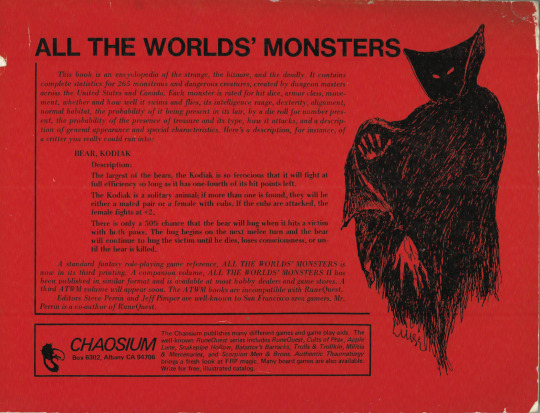
For instance, the description mentions that the kodiak can “fight at full efficiency so long as it has one-fourth of its hit points left.” There were some optional rules in OD&D that included dexterity reductions and various penalties at different percentages of HP loss. Such rules are difficult to implement, particularly at low levels, when a small hit will often take 75% of a PC’s HP, and adds yet another element(or two or three or four) to track. Regardless, people surely used those rules, and I imagine this part of the description was a special ability that applied only to those using these kinds of rules.
A kodiak mother gains bonuses in combat to protect her young and kodiaks have a chance of a hug attack, nothing too noteworthy or mind-blowing.
We end with a note about this being the third printing(it’s what I’ve got), there being another volume out, and a third on the way, and a line about the editors. Steve Perrin is one of them, and the blurb mentions that he’s the “co-author of RuneQuest,” a game I like very much, personally. Then some info about Chaosium and where you can write for info and so on.
The book itself is 109 pages, with the last 3 pages unnumbered, as they are tables, specifically, a monster level chart, to help with placing the monsters found in the book on the appropriate dungeon level, and a table for creating random monsters. Perhaps we’ll roll up a few in a future installment for fun.
The Book’s Introduction Page
Opening the cover we get a title page and introduction. If you thought the sideways book was just a feature of the cover - it’s not. The whole book is like this. And I have to say, I tried to be open minded about it. I told myself “You’re using it the same as you’d use any book except for how it’s turned, it doesn’t actually make any difference.” I hate when something is done in a new way and everyone rejects it because it’s different. While I can see the flaws in it, I really loved the Monstrous Compendium stuff made with hole-punched pages for sorting in a looseleaf binder. I feel like it failed less because of the flaws in it and more because it seemed too different, and was simply dismissed out of hand. So I try really hard not to do that.
But the format really bugs me.
Moving on to the introduction, I have to wonder how close this is to whatever introduction was originally written, since it opens by mentioning that this is the third printing. Mr. Perrin goes on to tell us that it was made for “games such as Dungeons & Dragons, Tunnels & Trolls, and the Arduin Grimoire.”
I have a few comments on this. Originally I wanted to say it was neat how this early one could simply reference D&D like that without a problem, but apparently the book did, in fact, cause a stir with TSR. I have not listened to the linked podcast, but the description says that this was the case. Once this readthrough is complete, I’ll go back and listen to the podcast; I’d like to get my own impressions, and maybe make a few guesses at some things, and see if I’m right or how much my ideas mesh with what they say.
Tunnels & Trolls(another game I quite like) is interesting since it didn’t really have monster stats, so using these in that game would be more for descriptive flavor.
As for the Arduin Grimoire, for those unaware, it was originally written as a sort of expansion and add-on to OD&D. This, too, caused problems, and it eventually became its own game(despite never playing it, its monster the “vampusa” remains a favorite of mine to this day). Gary Gygax mocked it in the form of a cursed item in AD&D, a book that drives the reader insane(one might have assumed it was a Lovecraft inspired item, but its inspiration was pure spite).
It goes on to tell us that they have 50,000 monsters, and how they might not use yours and how they chose the ones that went in here, info about the art, where to mail feedback about the monsters you want to see. What’s of real interest here is the mention that Dave Hargrave and Paul Jaquays gave them permission to use some of their own copywritten monsters, but these had to be removed due to space limitations. They then recommend Mr. Hargrave’s Arduin Grimoire(I’m sure that helped endear them to TSR), among other things, as well as several publications by Jaquays. These were presumably the publications from which the monsters would have been taken, and we’re told they will be in future volumes of AtWM.
Table of Contents
Skimming through, there are some really neat looking ones.
Archer bush? That was a later Mystara monster adapted into 2nd ed and currently 5e(not sure if it was in 3e or 4e or not and don’t particularly care). Sometimes it’s hard to say if multiple people had the same idea or one ripped the other off. Especially in this early time when lots of people were putting out monsters and few had previously, people were bound to have similar if not identical ideas. Such things have happened in much less likely circumstances.
Some very odd ones right off the bat. Snake ape? On the other hand, things like “air squids” are why I read these kinds of collections.
Batarang. Was DC ever notified of this infringement?
Plenty of slimy monsters: blue horror(which I’m guessing is a slime-type?), red blob, maybe “brown ich?,” gelatinous blue horror(maybe the original isn’t a slime after all), green slime golem. Eh, maybe not as many as I thought. We’ll get a better idea as we read through them, I don’t want to spend all day browsing the contents. And neither do you, I’m sure!
Vampire bear. Heh. Brain stealer(geteit chemosit). Is that German? I feel like I’ve seen other monsters in here with similar names. Will have to see if that’s true and if they’re written by the same author.
Carnivorous… typo? Carnivorous typo. Typo, carnivorous. Are you serious? If this doesn’t end up being some kind of meta monster I’m going to be quite disappointed.
Here’s another thing about the formatting. It makes sense as a normal book, in that one column continues in the column to its right. But because of the formatting of the book, you expect it to continue down the column on the next page below it. It’s a small thing, honestly, but it’s noticeable.
A lot of monsters that would see official stats later, as expected. Crocotta, cyclops, various demons - but no devils! There’s a “sun devil,” but since there’s no “devil” category I figure it’s a devil in the way a tasmanian devil is a devil - in a non-literal sense. It looks like there are some traditional powerful monsters from myth and legend among the demons, as Ymir(“Prince of Ice Demons”) is one of them, and some of these others may turn out to be similar things - it’s hard to tell from the names, such as “serpent king” and “twelfth plane,” which yes, is the name of a demon. As three demons are listed as “ice,” I imagine they were going more for a frozen Hell as opposed to a fiery one, which would be why they used Ymir instead of Surtr. The latter would have been a much more obvious choice, being a fiery giant who is to burn the universe to ashes as the grand finale of the final conflict between good and evil(yes I’m simplifying it, this isn’t a mythology lesson).
A good number of golems, including diamond, dust, the aforementioned green slime, ice(unusual but not impossible in a magical world, or in frozen places, where they’d be quite evocative), quicksilver(which would also appear in Mystara as simply “silver golems”), wood(ditto), and oddest of all - tar.
Ground octopus, like “air squid,” is the kind of thing I read these books for. Again, there’s kind of a similar monster in Mystara, the decapus, which tends to live in trees. Personally, my favorites are the octorocks of the Legend of Zelda series. While mentioning both air squids and video games, I’ll throw in that the Japanese Super Mario Bros 2 featured flying squids as well. I should also mention that I haven’t played video games in 30 years, so I will routinely recall things like this and not the 3,000 instances of them that have likely appeared in video games in the interim.
I never thought I’d see triffids in a monster book. I love it! Some Lewis Carrol monsters, some from myth and legend, such as the “three sons of Argatron.” I had to look that up, by the way, as it sounded historical but I wasn’t sure. Google corrected me to some random other word first, and then when I insisted that it search for what I actually typed, it pulled the legends right up. I didn’t read them though; we’ll do that when we get to the entry! Man-Scorpion, another monster not yet statted. As far as I know, they’re usually called “scorpion men,” so the formatting of “man” first is an unusual coincidence and I wonder if there was some famous or classical text popular at the time that used that form. At any rate, it says “see Humbaba,” who, if I’m not terribly wrong, was not a scorpion man.
There are several Lovecraftian things, including stats for Nyarlathotep. I believe I have probably 3 or 4 sets of stats for him, for various editions of D&D, and I look forward to contrasting them all and seeing how they compare, especially this earliest one to, say, the newest one I have. Of course, being published by Chaosium, they had the rights to these monsters.
Not so much the olog-hai, which was a direct property of the Tolkien Estate. If “hobbit,” a word Professor Tolkien did not even invent, had to be removed from early versions of D&D, one must imagine that the only reason the same didn’t occur here is that this book flew under their radar. (In fact, I believe hobbits were removed by choice, in order to prevent future legal issues, but this is another point I could be quite wrong on.)
Let’s move on and not spend all day speculating and rambling about a table of contents, shall we?
Creators
I don’t want to add up the number of creators used, as many are combinations of creators and so forth. Dan Pierson created the largest number of monsters, with 28 entries printed in the book. It seems like the average is about a dozen or a bit less, just glancing at the numbers and guessing. If someone cares enough to do the math, have fun.
One little point is the last line: “There are 265 entries and 113 cross-references.” So out of these monsters, almost half of them are related to(in some way or another, whether as biologically related, as enemies, or whatever) others. If that’s what it means, that would make some sense given that some creators contributed a dozen or more monsters, and there’s often going to be such connections(such as someone creating a number of “ice demons”). This kind of thing is good, as it can be incorporated to give the denizens of your world, and your world by extension, more of a feeling of depth and history, that these monsters have relations, alliances and rivalries, and aren’t just a set of numbers.
“Interpreting the Monster Entries”
An explanation of what the stats mean and so forth. There are a few points of interest here. They mention that random numbers are “expressed as die rolls,” in case you played D&D and somehow didn’t know what 3d6 meant. This is great though, as it saves the trouble of figuring out what to use to determine 3-6(it’s 1d4+2). There are reasons that Gygax chose to express numbers as, say, the aforementioned 3-6 instead of 1d4+2, which was to emphasize that the numbers were important and not how they were generated, opening people up to new dice rolling conventions and so forth. Unfortunately, what it mostly did was confuse people with some of the more difficult to interpret number ranges.
We’re told that intelligence is abbreviated as IQ(as it is in the later GURPS) and expressed as a die roll - so instead of being told “very” or given a specific number, we’re given dice to roll to determine the intelligence of any given monster. (I do this in my own games and monster stats, so it’s nice to see someone else doing this a number of years before I was capable of playing.)
Most of the rest of the explanations are mundane and not worth reviewing, it’s basic information.
One thing it doesn’t bother to explain or mention is the fact that it has a dexterity range for each monster in the same way it has an IQ range. Here, dexterity is abbreviated DEXT., which makes me wonder if the DEX abbreviation had been used yet on character sheets or was still a little bit away? Remember, this book was released after Holmes Basic and before a single AD&D book, including the first AD&D book released, the Monster Manual.
More importantly than the abbreviation is why that was there. It was there because in Holmes Basic, the melee combatants attack in order of dexterity, regardless of who won initiative or initiated combat. The Holmes book mentions the question of “who strikes the first blow?” as one unresolved in OD&D, which seems very odd. OD&D never really explained initiative at all, and expected you to default to Chainmail order of initiative. It may have not expected you to use the combat “phases,” but just the die mechanic that determined which side acted first - that being a d6 and the higher goes first. Later versions would have the lower roll act first, with the option to positively/detrimentally modify the roll by weapon speed. There is mention that dexterity might affect various things including initiative, but there’s no exact rule explaining how. Most people just assumed that the one with the initiative attacked first, and this was how the game has been played, for the most part, ever since(and I imagine, for most, during and before, as well). Personally, I think it’s great, and would enjoy trying the rule out. I favor using phases and aspects of combat that add some amount of strategy, where “I run up and attack” can often be detrimental to waiting for a more opportune moment and so forth. I’d prefer the combat phases, and have played with them for many, many years, but I’d be quite open to the Holmes Basic version of combat. (Someone want to run it for me?)
As yet another digression, it’s funny how often I’ve played games with people that ran their system of choice for decades, sometimes since the game was released, and never knew how initiative actually worked in said system. People get so used to it working a certain way in lots of games, and they either never consult the rule in their own game, or forget it and replace it in their mind with another. I’ve played in multiple Marvel Super Heroes games where everyone rolled a d10 for initiative, and when I pointed out it was one die per side, the judges in each case looked at me quizzically and then continued doing it how they had been doing it forever. The fact that they had been performing the most basic part of their favorite game wrong for 30+ years was too much to consider so it was simply dismissed.
And with that, I’ll wrap this first entry. I hope it wasn’t too boring - I know I ramble and digress, but it’s kind of part of the point I suppose. I hope you’ll stick with me for the monsters, even if you found this part kind of weak, and that you’ll let me know what you think, as well, because I want to go over this with you, not just read a review to a brick wall. It’s not a review, it’s a readthrough, me and you, if you please.
So.
Let’s read All the World’s Monsters together!
#D&D#AD&D#tunnels and trolls#arduin grimoire#chaosium#OD&D#holmes basic#holmes blue book#monster manual#all the world's monsters#readthrough#read through#review#osr#rpg#rpgs
1 note
·
View note
Text
Critical Hits and injuries
At the dawn of time we played around the kitchen table with a mishmash of rules. I thought these were just how the game was played. In reality how the game was played varied quite a lot, almost everything was house rules.
One of the rules that we used a lot was the Critical Hit and Fumble tables from the Arduin Grimoire by Dave Hargrave. The rule was, on a natural 20 you rolled a critical hit.…

View On WordPress
0 notes
Photo
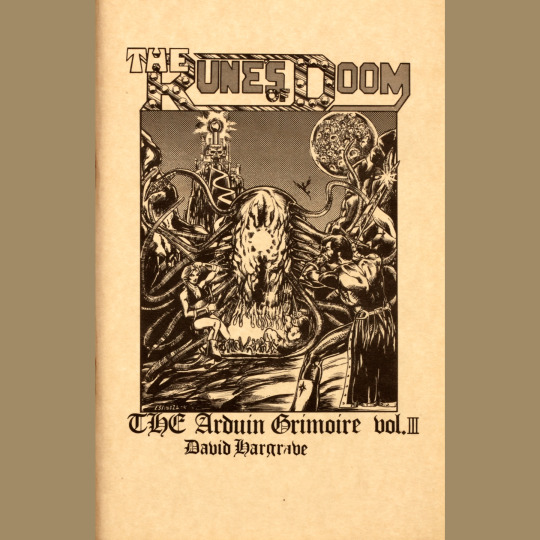



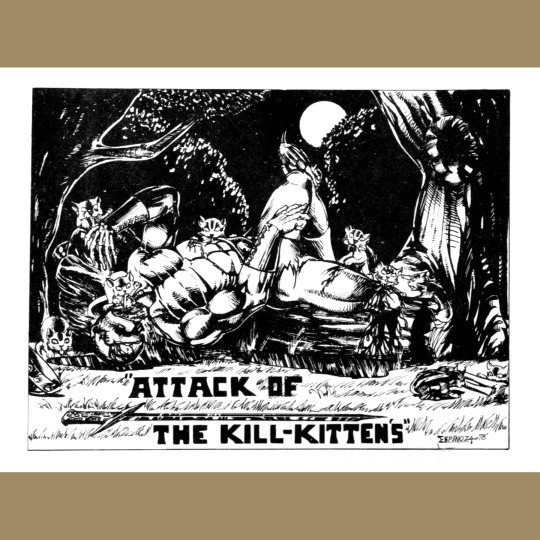



Runes of Doom (1978) finally ties up threads left dangling from the other two volumes. Thank goodness. It is probably my favorite of the Grimoire series.
First off, we finally have rules for playing Phraints, humanoid insect warriors that are repeatedly mentioned as playable in the previous books, but without any indication as to how play them. I’d wouldn’t be surprised if you told me that they directly inspired D&D’s Thri-Kreen.
Second, we finally get stats for the energy weapons used by the Techno class, which cements Arduin’s commitment to a strong flavoring of science fantasy, two years before Expedition to the Barrier Peaks saw print.
Third, we can see a lot more of Hargrave himself coming through. An illustration towards the back of the book is entitled “Attack of the Kill Kittens,” which gives you a sense of his humor and to the overall uncompromising nature of his games (though, considering his claim in Skull Tower of having killed over 480 player characters in four years of running his campaign, I suppose that shouldn’t be a surprise). You also get a sense of what Lawrence Schick meant when he said that Arduin is “unencumbered by good taste,” thanks to the illustration of a topless, axe-wielding woman warrior captioned “Shardra the Castrator.” As ever, your mileage will vary.
Oh, Runes of Doom also reveals Hargrave’s preoccupation with demons, with 13 pages dedicated to new infernal entities of all stripes. I am sure he’d have been pissed had he lived long enough to see TSR remove devils and demons from D&D.
#RPG#TTRPG#Tabletop RPG#Roleplaying Game#D&D#dungeons & dragons#Arduin#Arduin Grimoire#David Hargrave#Runes of Doom#Greg Espinoza#Erol Otus
73 notes
·
View notes
Photo

A human wizard and an insectoid Phraint swordmaster rush to aid their fighter companion as a manticore lunges from the darkness (Morno / Bradley W Schenck, back cover of The Arduin Grimoire Vol II: Welcome to Skull Tower by Dave Hargrave, Grimoire Games, 1978)
#Arduin#The Arduin Grimoire#Morno#Bradley W Schenck#manticore#Phraint#Arduin Grimoire#Welcome to Skull Tower#Dave Hargrave#Grimoire Games#The Arduin Grimoire Vol II#dnd#D&D#Dungeons & Dragons
114 notes
·
View notes
Text

Area 2-24: Hall of the Warring Doors, from Jennell Jaquays' AD&D adventure Dark Tower (Judges Guild, 1979). Doors have been causing problems for adventurers since the earliest days of dungeon crawling, either locked or stuck, studded with complex traps, or occasionally coming to life. I've always suspected the quarrelsome door "Hargrove" was a reference to the famously argumentative Dave Hargrave, creator of The Arduin Grimoire.
#D&D#Dungeons & Dragons#Jennell Jaquays#Dark Tower#Judges Guild#dnd#dungeon door#Dungeons and Dragons
74 notes
·
View notes
